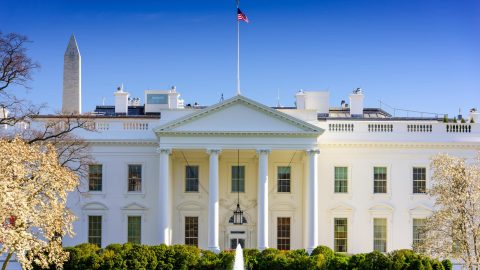 Author: Felix Dornaus, Senior Fundmanager
Author: Felix Dornaus, Senior Fundmanager
The Trump administration should be keeping the financial markets on their toes in the coming weeks. Yet again, the issue is the government debt which will soon reach its statutory maximum.
The USA imposed a maximum amount of debt, or a debt ceiling, a few years ago (currently USD 19,900bn). Up to this threshold, the government can independently decide as and when it wishes to take out loans to fund expenditures within the annual federal budget laws. This would not be a problem, because in the past the debt ceiling would have usually been raised in order for the USA to be able to pay its bills.
Moratorium on expenditures: no money for civil servants
In 2013 the Democrats under then-President Obama and the Republicans were at each others’ throats about this issue. This resulted in a moratorium of expenditures that lasted a few days and resulted in a government shutdown. This means only the most important expenditures were approved, museums remained closed, numerous civil servants had to wait for their wages, and some 800,000 of them were furloughed. The services of non-essential organisations/institutions funded by the state were reduced or even discontinued. This affected for example certain healthcare institutions and internal revenue offices.
When exactly the USA will be running out of money is subject to guesswork at best. But without a deal between the parties involved in this situation, we might be there between the end of September and the middle of October. The summer break of the US Congress will end on 5 September, at which point the heated phase of negotiations should be kicking off. And there is not much time to reach an agreement.
Uncertainty on the bond markets
The uncertainty has already caused short-term US Treasury bonds falling due in October to underperform vis-à-vis those that expire in November. The bonds maturing in October recorded an increase in yield to about 1.04%, the highest rate since 2008.
We remember 2013: what happened then?
10Y treasury bonds: After a high of about 3% on 5 September 2013, the yield fell by about 50bps (100bps = 1%) during the government shutdown (30 September to 16 October 2013). It took the yield until the end of December to climb back to 3%.
Equities: From 18 September 2013 to 8 October 2013, the Standard & Poors index dropped by about 75 points (i.e. -4.3%) but did recover more quickly and had recovered the losses by 17 October 2013.
US dollar: From 5 September 2013 to 22 October 2013 (i.e. the starting point of the recovery), the Bloomberg USD Spot index lost about 3.8%.
US O/N repo rate: Increase of about 0.05% to 0.23% (from the beginning of September to the middle of October 2013).
No deal yet
The leaders of the Republican Party are in favour of passing a “Clean Debt Ceiling Bill”, i.e. one without expenditure or debt reforms as condition. Although the Republicans hold the majority both in the House of Representatives and the Senate, they will need votes from the Democrats for their plans. The reason is obvious: many Republicans are fed up and are against the official party line of increasing the debt ceiling yet again (net). They have tied their possible yes-vote to a tax reform. After all, some of them were not particularly pleased with this sort of situation under Obama either. The Democrats seem to tend towards an unconditional increase of the debt ceiling. In order to secure funding for the wall on the Mexican border, President Trump wants to legally tie it to the discussion about the debt ceiling. Otherwise he has threatened to put in a veto, which would cause the aforementioned shut-down.
Harvey as catalyst – short-term increase of the ceiling as solution?
As is often the case in difficult situations, things turn out differently than expected. The terrible hurricane Harvey, which carved a path of devastation through the country and caused previously unseen floods and destruction in Texas, might possibly lead the opposing parties to reach across the aisle. Nobody wants to be politically associated with the partial suspension of public services, especially when we are talking about the urgent transfer of aid payouts for the victims of the hurricane. Therefore, the debt ceiling might be raised sooner than expected, for the time being temporarily until the end of 2017. This would give the Congress and Trump more time to negotiate a sustainable solution.
Complete default unlikely but not entirely impossible
A complete default is unlikely, but cannot be ruled out. If it did happen, one would have to analyse whether the situation at hand were only a temporary disruption like in 2013 or whether the governability of the United States were sustainably and critically defunct. In such a case, we would probably see a significant increase in interest expenditure across the entire economy, which would trigger recessionary effects and a downgrade of the US country risk rating. Standard & Poors estimates that a government shut-down would create costs of at least USD 6.5bn per week, at a decrease in economic growth of 0.2% in Q4 2017. This would mean more intense frictional losses than the ones caused by the Lehman crisis.
Legal note :
Prognoses are no reliable indicator for future performance.
Legal disclaimer
This document is an advertisement. Unless indicated otherwise, source: Erste Asset Management GmbH. The language of communication of the sales offices is German and the languages of communication of the Management Company also include English.
The prospectus for UCITS funds (including any amendments) is prepared and published in accordance with the provisions of the InvFG 2011 as amended. Information for Investors pursuant to § 21 AIFMG is prepared for the alternative investment funds (AIF) administered by Erste Asset Management GmbH pursuant to the provisions of the AIFMG in conjunction with the InvFG 2011.
The currently valid versions of the prospectus, the Information for Investors pursuant to § 21 AIFMG, and the key information document can be found on the website www.erste-am.com under “Mandatory publications” and can be obtained free of charge by interested investors at the offices of the Management Company and at the offices of the depositary bank. The exact date of the most recent publication of the prospectus, the languages in which the fund prospectus or the Information for Investors pursuant to Art 21 AIFMG and the key information document are available, and any other locations where the documents can be obtained are indicated on the website www.erste-am.com. A summary of the investor rights is available in German and English on the website www.erste-am.com/investor-rights and can also be obtained from the Management Company.
The Management Company can decide to suspend the provisions it has taken for the sale of unit certificates in other countries in accordance with the regulatory requirements.
Note: You are about to purchase a product that may be difficult to understand. We recommend that you read the indicated fund documents before making an investment decision. In addition to the locations listed above, you can obtain these documents free of charge at the offices of the referring Sparkassen bank and the offices of Erste Bank der oesterreichischen Sparkassen AG. You can also access these documents electronically at www.erste-am.com.
Our analyses and conclusions are general in nature and do not take into account the individual characteristics of our investors in terms of earnings, taxation, experience and knowledge, investment objective, financial position, capacity for loss, and risk tolerance. Past performance is not a reliable indicator of the future performance of a fund.
Please note: Investments in securities entail risks in addition to the opportunities presented here. The value of units and their earnings can rise and fall. Changes in exchange rates can also have a positive or negative effect on the value of an investment. For this reason, you may receive less than your originally invested amount when you redeem your units. Persons who are interested in purchasing units in investment funds are advised to read the current fund prospectus(es) and the Information for Investors pursuant to § 21 AIFMG, especially the risk notices they contain, before making an investment decision. If the fund currency is different than the investor’s home currency, changes in the relevant exchange rate can positively or negatively influence the value of the investment and the amount of the costs associated with the fund in the home currency.
We are not permitted to directly or indirectly offer, sell, transfer, or deliver this financial product to natural or legal persons whose place of residence or domicile is located in a country where this is legally prohibited. In this case, we may not provide any product information, either.
Please consult the corresponding information in the fund prospectus and the Information for Investors pursuant to § 21 AIFMG for restrictions on the sale of the fund to American or Russian citizens.
It is expressly noted that this communication does not provide any investment recommendations, but only expresses our current market assessment. Thus, this communication is not a substitute for investment advice.
This document does not represent a sales activity of the Management Company and therefore may not be construed as an offer for the purchase or sale of financial or investment instruments.
Erste Asset Management GmbH is affiliated with the Erste Bank and austrian Sparkassen banks.
Please also read the “Information about us and our securities services” published by your bank.



